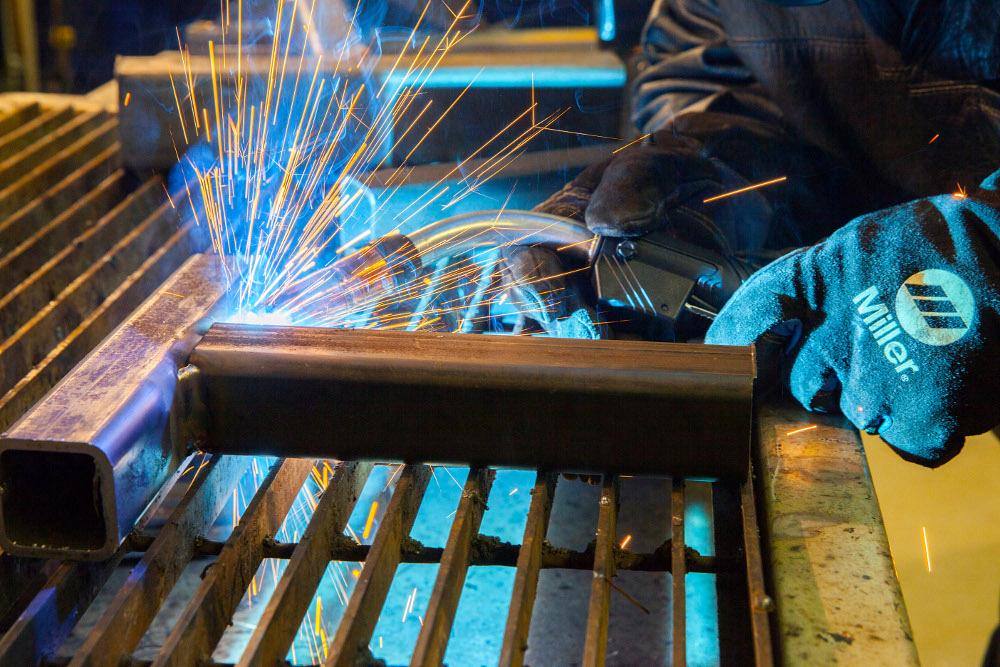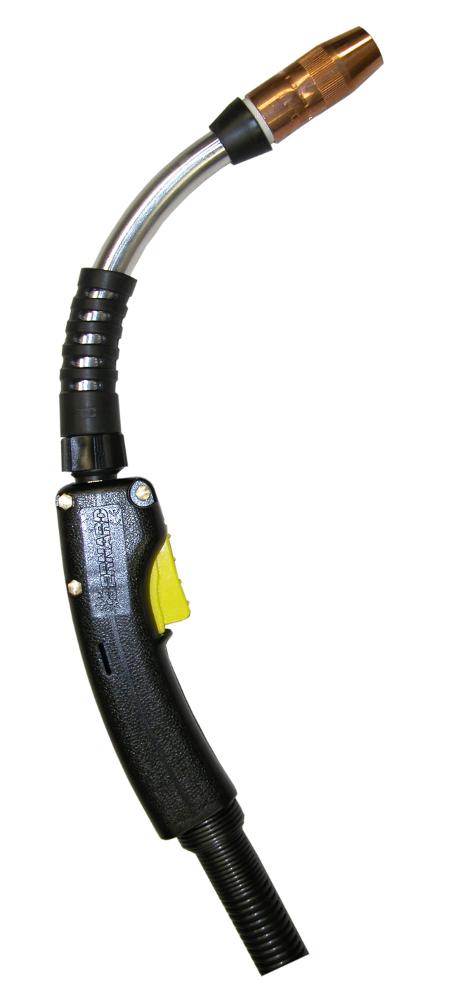Product Manager
- FMA
- The Fabricator
- FABTECH
- Canadian Metalworking
Categories
- Additive Manufacturing
- Aluminum Welding
- Arc Welding
- Assembly and Joining
- Automation and Robotics
- Bending and Forming
- Consumables
- Cutting and Weld Prep
- Electric Vehicles
- En Español
- Finishing
- Hydroforming
- Laser Cutting
- Laser Welding
- Machining
- Manufacturing Software
- Materials Handling
- Metals/Materials
- Oxyfuel Cutting
- Plasma Cutting
- Power Tools
- Punching and Other Holemaking
- Roll Forming
- Safety
- Sawing
- Shearing
- Shop Management
- Testing and Measuring
- Tube and Pipe Fabrication
- Tube and Pipe Production
- Waterjet Cutting
Industry Directory
Webcasts
Podcasts
FAB 40
Advertise
Subscribe
Account Login
Search
Customizing your GMAW gun for the job
- By Andy Monk
- June 15, 2016
- Article
- Consumables

Customizing your GMAW gun to match your application can make a big difference in improving your comfort and gaining the best welding performance.
The heat and repetitive motions that accompany gas metal arc welding (GMAW) can take their toll. Customizing your GMAW gun to match your application, however, can make a big difference in improving your comfort and achieving the best welding performance.
A GMAW gun’s trigger, handle, neck, and power cable design all help determine how long you can comfortably weld without experiencing fatigue or stress. By ensuring your comfort, you lessen the chance of injuries associated with repetitive movement and reduce overall fatigue. To help, some manufacturers offer online systems to help you configure a gun to your exact specifications.
Consider the following items to help you optimize your comfort and productivity and, ultimately, the profitability of your welding operation by allowing for greater arc-on time.
Triggers and Switches
Protecting yourself against the GMAW gun’s heat output is critical, both for your comfort and safety. So is having a trigger that doesn’t require more pull force than necessary to maintain the arc. Minimize that stress by selecting the right trigger for the job. There are several styles on the market.
- Standard triggers are used 98 percent of the time in general fabrication and manufacturing applications. However, some applications call for more customized triggers to help ensure operator comfort and safety.
- Locking triggers are offered on some guns and can help alleviate “trigger finger,” which can occur from repetitive grasping and gripping of the trigger. When you pull a locking trigger, it can be locked into place, allowing you to run a long, continuous weld without squeezing the trigger the entire time. These styles also are well-suited for high-amperage applications in which it is best to keep your hands farther away from the heat generated during welding. Once you’re done welding, you simply tap it again to unlock the trigger and shut off the gun.
- Dual-pull triggers look like standard models, but they have two built-in switches that allow you to toggle between two different schedules on the feeder. If the schedules are related to wire-feed speeds, for example, you can pull the trigger halfway to access a slower speed or pull it all the way to activate the higher speed. This feature is advantageous for pipe welding, for example, where faster speeds are needed when welding on the top of the pipe and slower speeds required underneath.
- Dual-schedule switches function the same as a dual-pull trigger, except the switch for the different modes is located on the side of the gun instead of inside the trigger. In this case, you simply flip the switch on the side of the gun to toggle between the two different schedules. While a side-mount dual-schedule switch can add a negligible amount of width to a gun, the one you use is a matter of preference, your required joint access, and whether you are left-handed, since most are configured for right-handed welding operators.
- Combined locking triggers with dual-schedule switches allow users to take advantage of the features offered by both options. Locking triggers can be locked into place, and when you want to switch between schedules, you can flip a switch on the side of the gun.
Whether you are better served by customizing a gun with a standard trigger or one of the other options is largely determined by your application. For applications that call for long. continuous welds or require you to switch from thicker to thinner materials often — or to quickly change wire-feed speeds to accommodate welding on a pipe or similarly varied structure — a special trigger can provide you with added comfort and productivity.
Handles, Necks, and Power Cables
To optimize your comfort when performing GMAW, be sure to select the appropriate handle, neck, and cables for the application. Typically, as a GMAW gun’s amperage decreases, so does the size of the gun handle and the cable, which makes the equipment easier to maneuver. However, it is not always possible to use a low-amperage gun, so you should implement safeguards to gain better ergonomics when using a larger model. The following features can help prevent undue strain to reach weld joints and reduce your risk of fatigue or injury.
Handles. GMAW gun manufacturers often offer handles in curved and straight models, according to your preference. The goal for both is the same: to choose a lightweight, comfortable style that also meets the GMAW gun and application’s amperage and duty cycle requirements.
You can mount the trigger on the top or bottom of straight handles. Top-mounted triggers are useful for high-heat applications or really long welds, particularly if you are in the habit of placing the power cable over your shoulder; you can use your index finger or first two fingers for the trigger. In this scenario, a straight handle with a lever-type trigger might be better than a curved handle with a standard trigger.
Some GMAW gun manufacturers offer ventilated handles, which help reduce heat by cooling down faster when not in use.
Power Cables. Choose the smallest and shortest power cable possible that can still meet the needs of your welding application. Smaller and shorter power cables are lighter and more flexible, which makes them easier to maneuver without stressing your wrists or hands and helps reduce fatigue.

A GMAW gun’s trigger, handle, neck, and power cable design all affect how long you can comfortably weld without experiencing fatigue or stress.
They also can help minimize clutter in the workspace and prevent excessive coiling that may be cumbersome for you to navigate and create a tripping hazard. Less clutter and coiling also reduce the chance of poor wire feeding, which could cause downtime and hinder productivity because of quality issues. Smaller and shorter cables also tend to cost less.
Necks and Neck Couplers. Many GMAW guns are available with rotatable and flexible necks in various lengths and angles, which can increase your comfort and control. These styles help improve access to restricted joints and can minimize unnecessary movement. For example, if you are welding a joint that requires a long reach or access at a tight corner, having a longer and angled neck can improve your comfort in that welding position. Rotatable necks are a good option for welding out-of-position (including overhead), as they can be adjusted to reach the weld joint without changing the gun handle or its position, thereby lessening the risk of fatigue or injury.
Adding a neck coupler can help you further customize your GMAW gun for the best control and joint access. These couplers combine two or more necks, allowing you to reach difficult joints more readily.
Many manufacturers also make custom necks, but these generally cost more than neck couplers and take longer for welding gun manufacturers to develop. If you need a more immediate and less expensive solution, the neck coupler may be the better option.
You might consider adding a neck grip or neck guard, too. These high-temperature silicone rubber or spring steel sleeves reduce heat exposure and can help you steady the gun. They allow you to rest the neck on your hand, using it as a pivot point to maneuver the gun more comfortably.
Remember, taking steps to customize your GMAW gun can improve comfort and control and, ultimately, provide you with better weld quality and increased productivity. It doesn’t have to be difficult to find the right gun for the job. Work with a trusted welding distributor and/or GMAW gun manufacturer for assistance.
About the Author
Andy Monk
449 W. Corning Road P.O. Box 667
Beecher, IL 60401
708-946-6726
About the Publication
Related Companies
subscribe now

The Welder, formerly known as Practical Welding Today, is a showcase of the real people who make the products we use and work with every day. This magazine has served the welding community in North America well for more than 20 years.
start your free subscription- Stay connected from anywhere

Easily access valuable industry resources now with full access to the digital edition of The Fabricator.

Easily access valuable industry resources now with full access to the digital edition of The Welder.

Easily access valuable industry resources now with full access to the digital edition of The Tube and Pipe Journal.
- Podcasting
- Podcast:
- The Fabricator Podcast
- Published:
- 04/16/2024
- Running Time:
- 63:29
In this episode of The Fabricator Podcast, Caleb Chamberlain, co-founder and CEO of OSH Cut, discusses his company’s...
- Trending Articles
Sheffield Forgemasters makes global leap in welding technology

ESAB unveils Texas facility renovation

Engine-driven welding machines include integrated air compressors

The impact of sine and square waves in aluminum AC welding, Part I

Compact weld camera monitors TIG, plasma processes

- Industry Events
16th Annual Safety Conference
- April 30 - May 1, 2024
- Elgin,
Pipe and Tube Conference
- May 21 - 22, 2024
- Omaha, NE
World-Class Roll Forming Workshop
- June 5 - 6, 2024
- Louisville, KY
Advanced Laser Application Workshop
- June 25 - 27, 2024
- Novi, MI



























